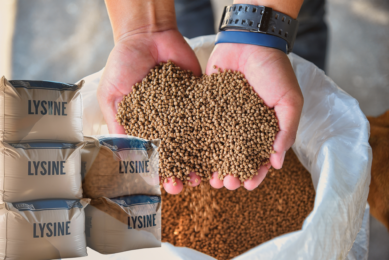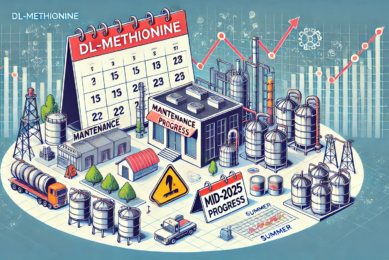Synthetic organic confusion
The relentless march of ‘organic’ foods into the supermarket aisles has prompted a few questions here in Australia, and it would be presumed elsewhere; how natural is the food covered by the ‘organic’ label? As the sector approaches the billion dollar mark in sales here, competition within the industry for production cost efficiencies grows: quicker growth, higher yields.
Tests revealed that synthetic methionine had been used to balance the amino acid profile in the diet of free-range meat birds. Twelve months ago, after much hand wrenching, the nation’s eight independent organic certifiers – eight certifiers for a market of 21 million potential consumers must tell us something of the nature of the industry – agreed to support new domestic standards.
Hand wrenching
Now the unrest returns; the country’s largest certifier, the Biological Farmers Association, is pushing to have synthetic amino acid isolates reinstated as an ‘organic’ feed ingredient. The hand wrenching begins anew.
Purists were of course alarmed, some possibly even horrified. Synthetic methionine is banned by the European Union in organically labelled produce and the US will phase it out by 2012.
The Pragmatists were philosophical. While being sympathetic to consumer concerns, they felt the industry had little choice. Essential amino acids are so called because they are just that – essential. They can’t be manufactured by the animal from other amino acids. The realists feel there are no ‘natural’ options that would bring about the same outcomes.
With nutritional and country of origin regulations continually being updated so consumers are better informed to make their eventual choices about the food they buy, isn’t it about time some form of assurance was brought into the debate other than organic good, non-organic bad?
At crossroads
One would be excused for feeling that maybe the organic movement has reached a cross roads, and needs to focus on something more than how many organic chooks can dance on the head of a pin. With global population closing in on seven billion and mid Century estimates ranging from eight to eleven billion, the time for talk has passed and the time for immediate action on food production and food security has well and truly arrived.
Surely the challenge to the food producing industry is to develop a better understanding of the nutritional requirements of the species being farmed so as to specifically target that species nutritional requirements rather than look for loosely fitting substitutes for scarce existing ingredients.
After all, the corresponding increase in efficiency that follows the use of purified ingredients in a species whereby the nutrient requirement is well understood is the only way the world is going to be able to feed its mushrooming population. The corollary is – can the world afford to continue down the organic/natural path and bar the use of nature identical or purified ingredients?
Purified instead
Would it be easier for the organic movement to accept the term "purified" rather than "synthetic" when it comes to ingredients? There are two issues relating to organic or natural ingredients. The first is that all manufactured purified ingredients are "nature identical" in their molecular form, i.e. a molecule of synthetic methionine is exactly the same as a molecule of methionine that has been extracted from a piece of meat.
The second is the issue of combination with natural ingredients (or ‘organic’ ingredients for that matter). The active nutrient is contained within a naturally occurring structure of other nutrients and it is supposedly the interaction of the specific nutrient with the encompassing material that makes it better than the purified ingredient.
This is an interesting concept and suggests there is still a lot we don’t know when it comes to nutrition, and I think I would agree with that presumption when it comes to some aquaculture species. Unfortunately, much of the research works only serves to maintain this level of uncertainty (ref. the All About Feed item on feeding barley protein concentrate to tilapia).
Fish meal dilemma
If we disregard the marketing implications, the bottom line here is not so much can we produce food without synthetic ingredients as, are our food producing industries viable without them? For one sector in particular, where the main diet ingredient, fish meal, is a product of a wild harvest, the question becomes even more relevant: is aquaculture sustainable without the inclusion of synthetic ingredients?
A recent article in Food Magazine led with Casual consumers drive organic growth and commented that ‘knowing you can trust it is organic’ was one of the greatest barriers to purchase. Surely this must present a quandary to the movement. With several groups offering certification, each with its own level of purism and expediency, confusion in the market place looms as a huge marketing negative.
But surely the first thing to establish is what is a synthetic ingredient? And the second is where do you draw the line when giving it the ‘organic’ imprimatur? For instance, lysine is a fermentation by-product whereas methionine is a chemical by-product. All vitamins are manufactured to some degree either by extraction, fermentation or chemical means. The list goes on.
Drawing a line
The issue puts two immediate challenges to the organic movement. Firstly, where do they draw the line as to where ‘natural’ ends and ‘un-natural toxicity’ begins? And if ‘non-organic’ is so toxic, can we produce enough ‘organic’ food to sustain a population of six billion, let alone the predictions for mid century?
To hardnosed aquaculture people the issue is quite clear: their industry is unsustainable without synthetically produced ingredients.
Over the last couple of decades grain and legume growers’ bodies and research groups have been trying to work land grown proteins into aquaculture diets with limited success. There just isn’t the balance of nutrients in land-based ingredients, particularly essential amino acids, to make their use cost effectively comparable to fishmeal, until of course price drives the decision.
Minimising waste
But there’s a barb in the tail here. Feeding cost-reduced diets containing substituted ingredients may seem like the answer, but waste from a fishpond, fish cage or recirculation system has to be managed in a far more dynamic environment than terrestrial animal production. It’s not just a simple matter of sending in the scraper and front-end loader and spreading the waste as fertilizer. Minimizing waste from seafood diets is paramount in nutrition design for a vibrant and efficient industry.











